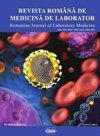Carbapenem resistance determinants in Klebsiella pneumoniae strains isolated from blood cultures-comparative analysis of molecular and phenotypic methods
IF 0.5
4区 医学
Q4 MEDICINE, RESEARCH & EXPERIMENTAL
引用次数: 0
Abstract
Abstract Introduction: This study provides data on carbapenemases identified in carbapenem-resistant Klebsiella pneumoniae (CR-KP) isolated from blood-cultures by the multiplex molecular method. Material and method: Between October 2016 and September 2017, 47 non-duplicate Klebsiella pneumoniae (KP) were isolated from blood cultures, from hospitalized patients in the Regional Institute of Gastroenterology and Hepathology, Cluj-Napoca, Romania. Identification and antimicrobial susceptibility tests (AST) were performed by Vitek 2 Compact. The combination disks test (CDT) was used for phenotypic analysis and the LightCycler® Multiplex DNA assay was used to detect and identify the carbapenemases by the LightCycler®z 480 Instrument. The following targets were chosen: blaKPC, blaNDM, blaGES, blaIMP and blaOXA-48 genes and the Cobas® 4800 software variant 2.2.0 was used for the results interpretation. Results: Taking into consideration the meropenem minimum inhibitory concentration (MIC), 29 KP were susceptible and 18 were not-susceptible (MIC≥0.5 µg ml-1). In the CR-KP group, the CDT identified OXA-48 (10/18) and KPC (7/18) producers. One isolate showed a noninterpretable profile. The multiplex molecular analyses confirmed the carbapenemases production as: 9 CR-KP were KPC and OXA-48 co-producers, 8 were OXA-48 and one was KPC producing strains. In CR-KP group, we found a significant correlation between the CDT and RT-PCR tests results, concerning KPC (p = 0.671). Eight phenotypic results were confirmed by molecular Light-Cycler® Multiplex DNA assay. For CR-KP co-producers (KPC and OXA-48), the CDT could indicate only one carbapenem-hydrolyzing enzyme. Conclusion: This study highlights the CR-KP co-producers (OXA-48 and KPC). OXA-48-like is more frequently encountered in our area than other carbapenemases.血培养分离的肺炎克雷伯菌碳青霉烯类耐药决定因素——分子和表型方法的比较分析
摘要简介:本研究利用多重分子方法对从血培养物中分离出的耐碳青霉烯类肺炎克雷伯菌(CR-KP)中鉴定出的碳青霉烯类酶进行研究。材料和方法:2016年10月至2017年9月,从罗马尼亚克卢日-纳波卡地区胃肠病学和血液病理学研究所住院患者的血液培养中分离出47株非重复肺炎克雷伯菌(KP)。采用Vitek 2 Compact进行鉴定和药敏试验(AST)。采用组合圆盘试验(CDT)进行表型分析,采用LightCycler®Multiplex DNA测定法通过LightCycler®z 480仪器检测和鉴定碳青霉烯酶。选择的靶点为blaKPC、blaNDM、blaGES、blaIMP和blaOXA-48基因,采用Cobas®4800软件变体2.2.0对结果进行解释。结果:考虑美罗培南最低抑菌浓度(MIC), 29个KP敏感,18个不敏感(MIC≥0.5µg ml-1)。在CR-KP组中,CDT鉴定出OXA-48(10/18)和KPC(7/18)产生者。一个分离物显示出无法解释的特征。多重分子分析证实产碳青霉烯酶的菌株为:9株CR-KP为KPC和OXA-48共同产菌,8株为OXA-48产菌,1株为KPC产菌。在CR-KP组中,我们发现CDT与RT-PCR检测结果之间存在显著相关性,与KPC相关(p = 0.671)。8个表型结果经分子Light-Cycler®Multiplex DNA检测证实。对于CR-KP的共同生产者(KPC和OXA-48), CDT只能指示一种碳青霉烯水解酶。结论:本研究突出了CR-KP的共同生产者(OXA-48和KPC)。oxa -48样在我们的地区比其他碳青霉烯酶更常见。
本文章由计算机程序翻译,如有差异,请以英文原文为准。
求助全文
约1分钟内获得全文
求助全文
来源期刊

Revista Romana De Medicina De Laborator
MEDICINE, RESEARCH & EXPERIMENTAL-
CiteScore
0.31
自引率
20.00%
发文量
43
审稿时长
>12 weeks
期刊介绍:
The aim of the journal is to publish new information that would lead to a better understanding of biological mechanisms of production of human diseases, their prevention and diagnosis as early as possible and to monitor therapy and the development of the health of patients
 求助内容:
求助内容: 应助结果提醒方式:
应助结果提醒方式:


